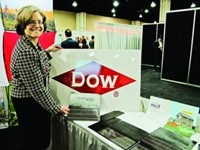Advertisement
Grab your lab coat. Let's get started
Welcome!
Welcome!
Create an account below to get 6 C&EN articles per month, receive newsletters and more - all free.
It seems this is your first time logging in online. Please enter the following information to continue.
As an ACS member you automatically get access to this site. All we need is few more details to create your reading experience.
Not you? Sign in with a different account.
Not you? Sign in with a different account.
ERROR 1
ERROR 1
ERROR 2
ERROR 2
ERROR 2
ERROR 2
ERROR 2
Password and Confirm password must match.
If you have an ACS member number, please enter it here so we can link this account to your membership. (optional)
ERROR 2
ACS values your privacy. By submitting your information, you are gaining access to C&EN and subscribing to our weekly newsletter. We use the information you provide to make your reading experience better, and we will never sell your data to third party members.
Energy
A Plethora Of Clean Energy
Innovation: ARPA-E summit shines spotlight on emerging technologies
by Jeff Johnson
March 1, 2012

Despite the nearly continuous attacks on clean energy spending by some in Congress, enthusiasm remains high for clean energy technologies being developed by the Department of Energy. At the agency’s third annual Advanced Research Projects Agency-Energy (ARPA-E) conference last week, Energy Secretary Steven Chu called for a “second industrial revolution” based on “innovation, invention, and discovery” to transform the world’s sources of energy.
Chu delivered this message to some 2,600 scientists, engineers, investors, business executives, and others gathered at the Energy Innovation Summit, held outside Washington, D.C. ARPA-E supports fledgling clean energy technologies. The secretary gushed over the new technologies that were on display at the conference.
Chu and most everyone speaking at the summit stressed the need for more spending for clean energy research, a tough proposition in a tight economy.
The summit included an unusual mix of high steppers not normally part of the emerging clean energy world, such as former president Bill Clinton, Microsoft Chairman Bill Gates, former Walmart CEO Lee Scott, and Xerox CEO Ursula M. Burns.
Along with pushing for research funding, Gates, Clinton, and many others lamented the nation’s unwillingness to move ahead and create a firm timetable to limit greenhouse gas emissions, which could help drive a clean energy economy. But each held a slightly different vision of how to develop that clean energy marketplace.
Gates urged development of advanced nuclear energy projects. He particularly pushed a company he supports, TerraPower, which is exploring the use of depleted uranium as a fuel. Clinton, while urging reduction in greenhouse gas emissions, also supported natural gas and oil development.
But most of the conference focused on emerging technologies, such as energy storage, electrical grid expansion, and renewable energy. It also highlighted some 180 projects funded by ARPA-E in technologies DOE believes are of critical importance to clean energy expansion. In all, more than 200 booths demonstrated these technologies, along with others that had been developed with DOE support.



Join the conversation
Contact the reporter
Submit a Letter to the Editor for publication
Engage with us on Twitter